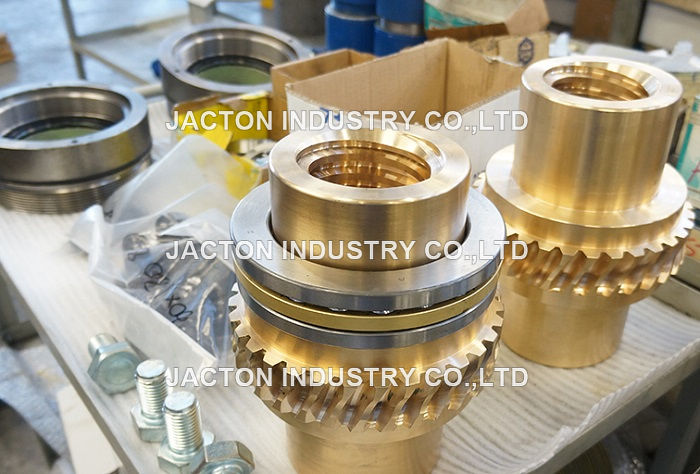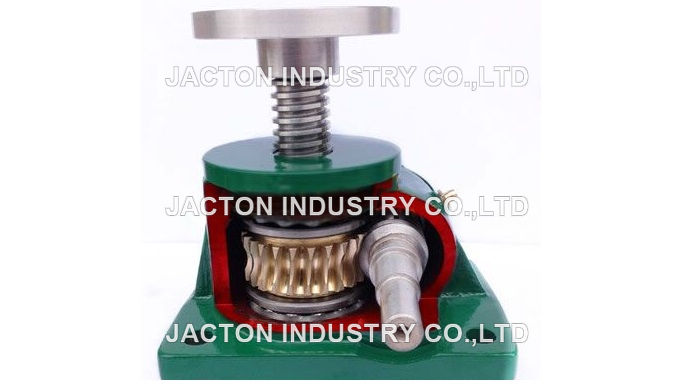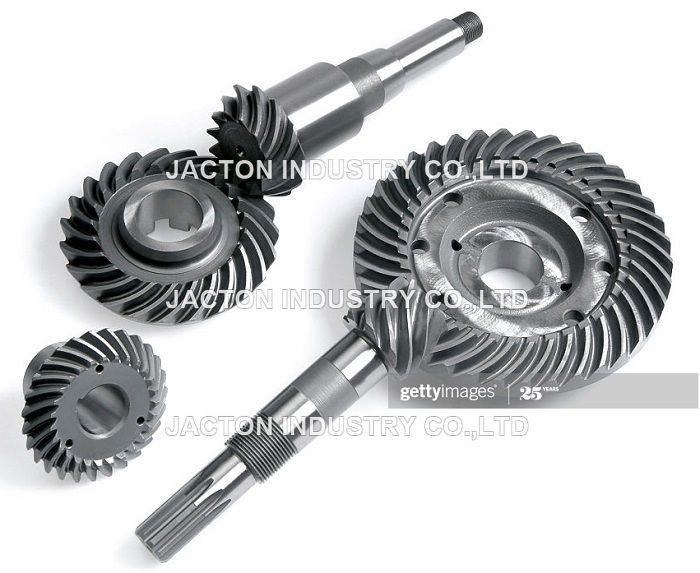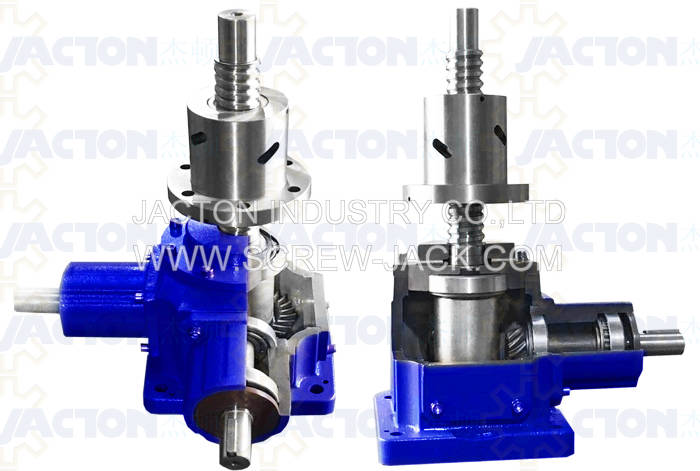News Details
The Differences Between Worm Gear Screw Jack And Bevel Gear Screw Jack, Worm Gear Jacks Vs. Bevel Gear Jacks, Worm Screw Jacks Vs. Bevel Screw Jacks
The Differences Between Worm Gear Screw Jack And Bevel Gear Screw Jack, Worm Gear Jacks Vs. Bevel Gear Jacks, Worm Screw Jacks Vs. Bevel Screw Jacks? When faced with the need to lift, lower, push or pull a load—especially a heavy load—and hold it in the correct position, a screw jack or multiple jacking system may provide the best linear motion solution when considering its performance and cost ratio. There are two main types of screw jacks: Worm Gear Screw Jack and Bevel Gear Screw Jack. To determine the type of screw jack that is best for your application, you need to consider several factors, they are load, self-locking capabilities, travel rate or travel speed, efficiency, accuracy, duty cycle and price, among others.
Worm Gear Screw Jack includes Machine Screw Jack and Ball Screw Jack. The key components of mechanical worm gear screw jacks are: trapezoidal lifting screw and lifting nut(machined screw jacks), or ball screw and ball nut(ball screw jacks), worm screw, worm gear and gear housing. The most common screw jack is the worm gear screw jack, also referred to as machined screw jacks because the acme, or trapezoidal, lead screw is machined. In addition to the low cost and self-locking characteristics, another advantage of machine screw jacks, and all screw jacks, is the mechanical advantage achieved through the internal gear ratio resulting in the ability to lift, lower, push or pull a significant load with a relatively small amount of torque on the drive shaft. Ball screw jacks incorporate a ball screw instead of a machined screw and a ball nut, which activates the screw. The advantage of ball screw jacks and the rolling action of their design is greater efficiency, up to 60%, which is much greater than machined screw jacks. Because of their efficiency ball screw jacks can be used in heavier duty cycle applications. They also provide good positional accuracy in high speed applications. One potential disadvantage is that ball screw jacks are not self-locking and will require a brake or motor with enough holding torque to prevent the ball screw from back-driving.


Bevel Gear Screw Jack Advance from having Screw Jack and Bevel Gearbox as a separate unit to a combined Miter bevel gearbox and Screw Jack in a single housing. The Bevel Jack product will save you money by offering less maintenance and fewer components. Available in many configurations, this line offers customers quality, long-duty cycles and configurable solutions for their applications. Available in Bevel Gear Machine Screw Jacks and Bevel Gear Ball Screw Jacks. Although worm gear jacks are sufficient for large loads that are infrequently moved, bevel gear jacks offer more flexibility and programmable options for a wider range of applications. The key components of bevel gear machine screw jacks use the same trapezoidal or acme screws used in machined screw jacks, or ball screws used in ball screw jacks to move the load. However, bevel gear jacks use spiral bevel gears set inside the housing instead of worm gearing. Bevel gears are more efficient than worm gearing, and they have lower ratios that result in higher speeds and travel rates. Typically, bevel gear machine screw jacks maintain self-locking characteristics while providing higher travel speeds, but bevel gear ball screw jacks incorporate a ball screw instead of a machined screw and a ball nut, which activates the screw. The advantage of bevel gear ball screw jacks and the rolling action of their design is greater efficiency, which is much greater than bevel gear machined screw jacks. Because of their efficiency bevel gear ball screw jacks can be used in heavier duty cycle applications. They also provide good positional accuracy in high speed applications. One potential disadvantage is that bevel gear ball screw jacks are not self-locking and will require a brake or motor with enough holding torque to prevent the ball screw from back-driving. Worm Gear Screw Jack includes Machine Screw Jack and Ball Screw Jack. The key components of mechanical worm gear screw jacks are: trapezoidal lifting screw and lifting nut(machined screw jacks), or ball screw and ball nut(ball screw jacks), worm screw, worm gear and gear housing. The most common screw jack is the worm gear screw jack, also referred to as machined screw jacks because the acme, or trapezoidal, lead screw is machined. In addition to the low cost and self-locking characteristics, another advantage of machine screw jacks, and all screw jacks, is the mechanical advantage achieved through the internal gear ratio resulting in the ability to lift, lower, push or pull a significant load with a relatively small amount of torque on the drive shaft. Ball screw jacks incorporate a ball screw instead of a machined screw and a ball nut, which activates the screw. The advantage of ball screw jacks and the rolling action of their design is greater efficiency, up to 60%, which is much greater than machined screw jacks. Because of their efficiency ball screw jacks can be used in heavier duty cycle applications. They also provide good positional accuracy in high speed applications. One potential disadvantage is that ball screw jacks are not self-locking and will require a brake or motor with enough holding torque to prevent the ball screw from back-driving.


Another benefit of bevel gear screw jacks is their drive shaft flexibility. They are available in single shaft, two shaft and three shaft configurations. In two and three shaft configurations the jack offers right angle characteristics with the ability to divide input power or torque, sending it equally in different directions. Flexibility in shaft configuration makes bevel gear jacks ideal for multiple jack configurations and can eliminate the need for stand-alone right angle gearboxes used in many worm gear jack systems. Additionally, our bevel gear screws can be arranged in three jack configurations: translating, rotating and keyed. This allows the load to be moved in different ways along the lift shaft, offering further options for customers.


Product List
Manual Electric Screw Jack
Worm Screw Jack
- JTC Cubic Screw Jack
- JTM Worm Screw Jack
- JSS Stainless Steel Jack
- JT Acme Screw Jack
- JTW Machine Screw Jack
- Through Holes Screw Jack
- Custom Made Screw Jack
Ball Screw Jack
Bevel Gear Jack
Miter Gearbox
- JT Classic Miter Gearbox
-
- Order Code for Classic Miter Gearbox
- Classic Miter Gearbox description
- JT15 Miter Gearbox
- JT19 Miter Gearbox
- JT25 Miter Gearbox
- JT32 Miter Gearbox
- JT40 Miter Gearbox
- JT45 Miter Gearbox
- JT50 Miter Gearbox
- JT60 Miter Gearbox
- JT72 Miter Gearbox
- JT85 Miter Gearbox
- Flange Input Solid Output Shaft Gearbox
- JTP Cubic Miter Gearbox
-
- Order Code for Cubic Miter Gearbox
- Cubic Miter Gearbox description
- JTP65 Small Miter Gearbox
- JTP90 Miter Gearbox
- JTP110 Miter Gearbox
- JTP140 Miter Gearbox
- JTP170 Miter Gearbox
- JTP210 Miter Gearbox
- JTP240 Miter Gearbox
- JTP280 Miter Gearbox
- Solid Input and Output Shafts Gearbox
- Solid Input and Hollow Output Gearbox
- Flange Input and Solid Output Gearbox
- Flange Input and Hollow Output Gearbox
- JTA Alu. Miter Gearbox
Lift System and Accessories
- Screw Jack System
- Lift System Accessories
-
- Flexible Jaw Coupling
- Overload Safety Couplings
- Aluminum Couplings
- Telescopic Universal Joint
- Rigid Shaft Couplings
- Universal Joint
- Cast Iron Hand Wheel
- Connecting Shafts
- Aluminum Handwheel
- YVF2 Series Variable Speed AC Motor
- Brake motors
- Three Phase Electric Motor
- Screw Jack Motor Flange
- Single Phase Induction Motors
- K Helical Bevel Geared Motor
- R Helical Geared Motor
- Worm Gear Reducer
- 12V 24V DC Geared Motor
- Proximity Switches
- Limit Switches
- Pillow Blocks
- Pillow Block Flange Bearing
- Digital Position Indicator
- Flange Blocks
- Ball Joint Rod End Bearing
- Bellows Boot
- Helical Gear Motor
- 12V 24V DC Motor
- Linear Bushings and Shafts
- Trunnion Adapters
- Servomotor
- Rotary Encoder
- Low Backlash Planetary Gearheads
- Stepper Motor
- 24V Planetary Gear Reducer
- Planetary Speed Reducer
- Frequency Inverter
- Hydraulic Cylinder Rod End Bearing
- Lift System Applications
Linear Actuators
- LAP Electric Linear Actuator
-
- 100KG Parallel Electromechanical Linear Actuators
- 250KG Parallel Electro Mechanical Linear Actuators
- 500KG Parallel Mount Rod Style Linear Actuators
- 630KG Parallel Mount Electric Cylinder Linear Actuators
- 1000KG Parallel Mount Industrial Linear Actuators Acme Screw
- 1600KG Parallel Electro-mechanical Actuators Heavy Duty
- 2500KG Parallel Mount Electric Cylinders Actuator
- 4000KG Heavy Duty Electric Linear Actuators Parallel Mount
- 6300KG Parallel Motor Drive Electric Actuator Linear Actuator
- 8000KG Parallel Electric Motor-Drive Linear Actuator
- 10000KG Parallel Mount Motorized Electric Linear Actuator
- 15000KG Parallel Industrial Motor Linear Actuator
- 20000KG Parallel Indistrial Motor Drive Linear Actuator
- 25000KG Parallel Electric Motor Linear Electric Actuator
- LA Electric Linear Actuators
-
- 10KG In-line Mini Electric Linear Actuators with Brake Motor
- 25KG In-line Electric Linear Actuator Push Rod
- 63KG In-line 700mm Stroke Electric Motor Linear Actuator
- 90KG In-line High Speed Motor Drive Electric Linear Actuator
- 100KG In-line Fast Speed Electric Linear Motor Linear Actuator
- 300KG Inline Industrial Electromechanical Linear Actuator
- 500KG In-Line Electric Linear Actuator
- 700KG Inline Heavy Electro Mechanical Actuators
- 1000KG In-line Heavy Duty AC Volt Industrial Linear Actuators
- JTE Classic Electric Cylinder
- Mechanical Linear Actuators
- JCA Cubic Electric Cylinder
Application
Jacton Industry Co.,Ltd.
 Contact: Warren Lee
Contact: Warren Lee
 Skype: jactonjack
Skype: jactonjack
 T: 86-769-81585810
T: 86-769-81585810
 F: 86-769-81585852
F: 86-769-81585852
 E: sales@jactonindustry.com
E: sales@jactonindustry.com
 W: www.screw-jack.com
W: www.screw-jack.com

 Contact: Warren Lee
Contact: Warren Lee Skype: jactonjack
Skype: jactonjack T: 86-769-81585810
T: 86-769-81585810  F: 86-769-81585852
F: 86-769-81585852  E: sales@jactonindustry.com
E: sales@jactonindustry.com  W: www.screw-jack.com
W: www.screw-jack.com 
VAT No. 9144190007026567X3, Copyright ©2013 www.screw-jack.com Jacton Industry Co.,Ltd. All Rights Reserved Site Map
Building 2, No. 1, DongCheng Road, Chang An, Dongguan, Guangdong, China. Phone: 86-769-81585810 | Fax: 86-769-81585852
China Screw Jack,Ball Screw Jack,Machine Screw Jack,Worm Gear Screw Jack,Bevel Gear Screw Jack,Miter Gearbox,Screw Jack Lift System Manufacturer
China Screw Jack,Ball Screw Jack,Machine Screw Jack,Worm Gear Screw Jack,Bevel Gear Screw Jack,Miter Gearbox,Screw Jack Lift System Manufacturer













